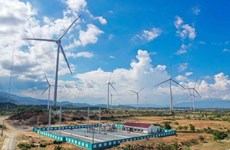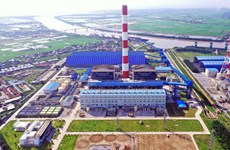Big challenge for VN’s economy in 2014
Maintaining last year’s reasonable rates of economic growth in 2014
presents a major challenge in the current economic context. A report by
Radio the Voice of Vietnam (VOV).
Maintaining last year’s reasonable rates of economic growth in 2014
presents a major challenge in the current economic context. A report by
Radio the Voice of Vietnam (VOV).
Vietnam’s GDP grew at 5.42 percent in 2013, approaching the 5.5 percent set target for 5.5 percent and higher than 5.25 percent in 2012.
Director of the General Statistics Office (GSO) Nguyen Bich Lam said the trend accords with long-term socio-economic development goals, especially considering the Government’s macroeconomic stability priorities. Slower growth is part of its policy strategy.
Lam says economic restructuring that favours the quality of growth over its magnitude will help Vietnam secure consistent, steady development.
Industrial production showed sign of recovery in 2013. The Index of Industrial Production (IPP) rose 7.4 percent, much higher than 2012’s 5.5 percent improvement. The processing and manufacturing industry accounted for more than 70 percent of added value.
Nearly half of the value of industrial production came from the foreign direct investment (FDI) sector. Impressive IPP improvement of 9–22 percent was seen in FDI businesses manufacturing textiles, drinks, clothes, electronics, computers, and leather. Exports also grew by more than 20 percent.
The increases in FDI production promote growth, expand export markets, and generate jobs. It demonstrates the health of Vietnam’s investment environment and its attractiveness to foreign investors. But added value remains low because of the manufacturing and assembling sectors’ reliance on imported input materials.
The manufacturing and processing industry’s consumption index is also following positive trends, rising from 1.5 percent in 2011 and 3.6 percent in 2012 to 9.2 percent in the 11 months of 2013.
By December 1, 2013, the manufacturing and processing industry’s stockpiling index had risen 10.2 percent above the previous year’s levels—another positive sign.
Statistics indicate domestic manufacturing lags behind in growth, management, competitiveness, and professionalism. Support industries and input material production is still substandard.
Sustainable development depends on high productivity, investment, and competitiveness in both the domestic and FDI sectors.
Lam said that the Government’s 5.8 percent growth target is a major challenge in 2014. Achieving its nine specific tasks will require united and assiduous efforts from all ministries and departments.
World prices, rising levels of investment, and the forecast spikes in the costs of commodities will affect the Consumer Price Index in 2014.
The lessons learned from recent macroeconomic management experience, together with monetary and fiscal policy flexibility, should keep a 2014 inflation rate below 7 percent well within reach.-VNA
Vietnam’s GDP grew at 5.42 percent in 2013, approaching the 5.5 percent set target for 5.5 percent and higher than 5.25 percent in 2012.
Director of the General Statistics Office (GSO) Nguyen Bich Lam said the trend accords with long-term socio-economic development goals, especially considering the Government’s macroeconomic stability priorities. Slower growth is part of its policy strategy.
Lam says economic restructuring that favours the quality of growth over its magnitude will help Vietnam secure consistent, steady development.
Industrial production showed sign of recovery in 2013. The Index of Industrial Production (IPP) rose 7.4 percent, much higher than 2012’s 5.5 percent improvement. The processing and manufacturing industry accounted for more than 70 percent of added value.
Nearly half of the value of industrial production came from the foreign direct investment (FDI) sector. Impressive IPP improvement of 9–22 percent was seen in FDI businesses manufacturing textiles, drinks, clothes, electronics, computers, and leather. Exports also grew by more than 20 percent.
The increases in FDI production promote growth, expand export markets, and generate jobs. It demonstrates the health of Vietnam’s investment environment and its attractiveness to foreign investors. But added value remains low because of the manufacturing and assembling sectors’ reliance on imported input materials.
The manufacturing and processing industry’s consumption index is also following positive trends, rising from 1.5 percent in 2011 and 3.6 percent in 2012 to 9.2 percent in the 11 months of 2013.
By December 1, 2013, the manufacturing and processing industry’s stockpiling index had risen 10.2 percent above the previous year’s levels—another positive sign.
Statistics indicate domestic manufacturing lags behind in growth, management, competitiveness, and professionalism. Support industries and input material production is still substandard.
Sustainable development depends on high productivity, investment, and competitiveness in both the domestic and FDI sectors.
Lam said that the Government’s 5.8 percent growth target is a major challenge in 2014. Achieving its nine specific tasks will require united and assiduous efforts from all ministries and departments.
World prices, rising levels of investment, and the forecast spikes in the costs of commodities will affect the Consumer Price Index in 2014.
The lessons learned from recent macroeconomic management experience, together with monetary and fiscal policy flexibility, should keep a 2014 inflation rate below 7 percent well within reach.-VNA












